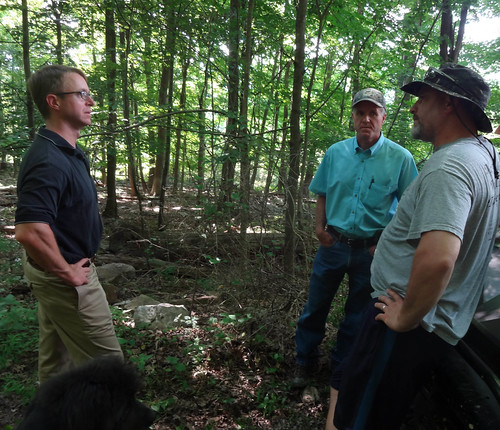
NRCS Chief Jason Weller (left) visited with NRCS District Conservationist Rob Clauto (center) and Blair County landowner Tom Belinda (right) to see some of the practices at work on the land.
When most people think of bats, images of dark caves, vampires and Halloween come to mind. But actually, bats get a bad rap, and we often don’t know how important they are for controlling insects, pollinating plants, dispersing seeds and improving biodiversity.
Many of our nation’s bats are facing population declines to near-extinction levels, primarily because of disease and loss of habitat. One of those species is the Indiana bat, an endangered species that has experienced rapid declines since the 1960s.
The Indiana bat, which has mouse-like ears, is found over the eastern half of the country. Indiana bats are a very social species, and they cluster together during hibernation. The bat got its name because the first one to be discovered was in 1928 in a cave in southern Indiana. The Indiana bat feeds on insects, and it is great for controlling mosquitoes and other flying pests. In summer, female Indiana bats gather into maternity colonies and each mother bat births, nurses and rears one pup under the peeling bark of an older-growth or diseased tree. The species spends its winters hibernating in caves or sometimes abandoned mines.
Unfortunately, this species is facing a new foe. White-nose syndrome, a fungal infection, is taking a toll on the Indiana bat and other bat species across the country, but there is hope.
With the help of biologists, private landowners, USDA is working to reduce the spread of this disease, as well as promote protection of high-quality habitat. For example, USDA’s Natural Resources Conservation Service (NRCS) assists Thomas and Wendy Belinda of Blair County, Pennsylvania, to improve the management of forests on their land. The Belindas are working to ensure diverse, open forests for the bats’ survival, as the bats prefer roosting in the cavities of large trees or under loose tree bark in open forests where the sun’s penetrating rays provide warmth.
The Belindas are planning and implementing a variety of management practices to restore more than 800 acres of forestland through the Healthy Forest Reserve Program—one of the Farm Bill programs available to landowners to receive assistance for adopting conservation practices. Through this program, the Belindas enrolled their land into a permanent conservation easement and have made a number of improvements, including removing competing trees, retaining highly preferred roosting trees and controlling invasive species.
Located in a key area adjacent to state game lands and nearly connecting to a nearby state park, the Belindas’ easement is part of a corridor of permanently protected Indiana bat habitat totaling approximately 21,000 acres. NRCS staff are also actively working with other nearby landowners, which will expand this corridor even more. These efforts provide better quality and more secure summer breeding habitat for Indiana bats with the hope that the species will once again thrive in this area.
No comments:
Post a Comment
Note: Only a member of this blog may post a comment.